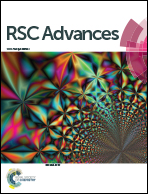Spectroscopic exploration of drug–protein interaction: a study highlighting the dependence of the magnetic field effect on inter-radical separation distance formed during photoinduced electron transfer
Abstract
In this article, we study the binding interaction of acridone (AD) with human serum albumin (HSA) using conventional spectroscopic techniques and then decipher the latent occurrence of photoinduced electron transfer (PET) using the laser flash photolysis (LFP) technique in conjunction with a weak magnetic field (MF). The experimental observations are further substantiated by docking results. An absorption study reveals the formation of a ground state complex between AD and HSA while a circular dichroism study implies that AD brings about a substantial change in the secondary and tertiary structures of the protein. A fluorescence study mainly helps in evaluation of the binding and thermodynamic parameters. This is one of the rare reports which utilize time-resolved emission spectra and time-resolved area normalized emission spectra to study drug–protein interactions. The detection of the occurrence of PET would be ignored if only the observations of conventional spectroscopic techniques had been considered. LFP detects the occurrence of PET from the tryptophan residue of HSA to AD and MF effect authenticates the triplet origin of the radical ions involved. Furthermore, the actual reaction pathway is elucidated with the help of the MF effect. Although the MF effect is generally observed in a restricted medium, in the present case the complex structure of the protein offers pseudo-confinement to the radical pairs or radical ion pairs resulting in observation of a substantial MF effect. The significance of maintaining the condition of “pseudo-confinement” or the optimum distance between radical ions originating from the acceptor and donor moieties in the observation of the MF effect has been specifically highlighted in this work by integrating the findings of the present study with our previous reports.


 Please wait while we load your content...
Please wait while we load your content...